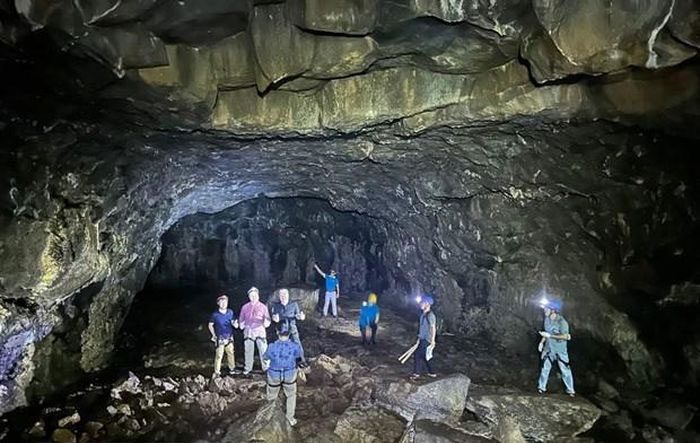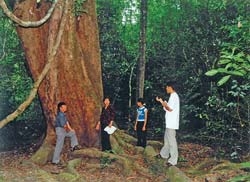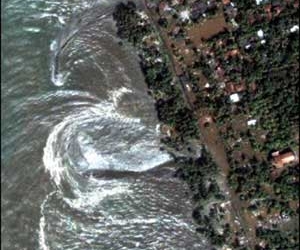Cave C6-1 is not only a geological heritage site but also the location where scientists have discovered and excavated prehistoric human remains with multiple cultural layers dating back 6,000 to 7,000 years.
Located in the volcanic cave system of the Global Geopark Dak Nong, Cave C6-1 (commonly referred to as Mâng ling Pian by the M’nông people) is situated in Dak Sôr commune, Krông Nô district, and is considered a unique heritage site in Vietnam and Southeast Asia.
Cave C6-1 serves not only as a geological heritage site but also as a valuable archaeological location. Here, scientists have discovered and excavated prehistoric human remains with various cultural layers dating back 6,000 to 7,000 years.
The cave was first explored in 2017 and excavated twice in 2018 and 2019.

A UNESCO Global Geopark expert team visiting some points in the Dak Nong volcanic cave system. (Photo: TTXVN).
Through excavations at Cave C6-1 and C6, archaeologists have uncovered many stone artifacts, including tools and pottery, as well as bones and mollusk shells. Scientists also found traces of fire pits, three burial sites, and remains of ten individuals, including five infants, one adolescent, and four adults.
Significantly, archaeologists discovered a skeleton and skull of a four-year-old girl, buried in a seated position with her knees drawn to her chest.
According to scientists, the archaeological heritage of the Krông Nô volcanic caves, which preserve cultural relics, burial sites, and the living activities of prehistoric tribes, is a unique heritage site in Vietnam and Southeast Asia.
The first discovery of prehistoric human remains in volcanic caves marks a groundbreaking achievement for the field of anthropology in Vietnam. This represents a significant accomplishment for Vietnamese scientists.
The artifacts recovered included 76,425 animal bone fragments and hundreds of thousands of mollusk shells; thousands of debris pieces, raw material stones, and 179 stone tools, notably including Hoà Bình cultural tools such as oval-shaped axes, short axes, disc-shaped tools, and iron-like tools; additionally, there were 1,276 pottery fragments and one bronze arrowhead.
Based on the cultural layer structure, 14C dating, and the assemblage of artifacts, it can be seen that Cave C6-1 consists of two cultural phases: an early phase existing from 7,000 to 5,500 years BP, and a late phase dated from 5,500 years to around 4,000 years BP.
Research results on Cave C6-1 have provided new insights, marking the first time Vietnamese and Southeast Asian archaeologists have recognized a type of archaeological site related to volcanic caves.
Historically, the Central Highlands region has indeed witnessed a Middle Neolithic phase after Hoà Bình. The residents here retained elements of Hoà Bình culture while also introducing new elements as they adapted to the volcanic environment of the Central Highlands.
With its geological and archaeological values, in March 2023, the National Heritage Site of Cave C6-1, part of the UNESCO Global Geopark Dak Nong, was recognized by the Ministry of Culture, Sports and Tourism as a National Heritage Site.
The ceremony to receive the National Heritage Site designation for Cave C6-1, within the UNESCO Global Geopark Dak Nong, was held on the evening of June 27 at the Dray Sáp-Gia Long waterfall tourism cluster in Dak Sôr commune, Krông Nô district.
During the ceremony, Ms. Tôn Thị Ngọc Hạnh, Deputy Chairwoman of the Dak Nong Provincial People’s Committee, emphasized that this event marks a significant milestone in the journey to preserve and promote the value of the heritage site, honoring the remarkable historical and cultural values of Cave C6-1.
Regarding the re-evaluation of the Global Geopark Dak Nong, from June 27-30, a team of experts from the UNESCO Global Geoparks network and the leadership of Dak Nong province, along with relevant sectors, organized surveys and evaluations of 44 heritage points across three tourism routes in the province.
During the re-evaluation process, the expert team will gather documents and engage in various activities. Through this, experts will provide recommendations to contribute to the development of the Global Geopark Dak Nong.





















































